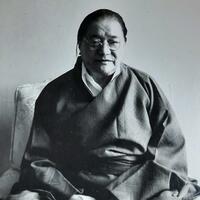
Dudjom Rinpoche
The Second Dudjom Rinpoche, Jigdral Yeshe Dorje (bDud-’joms Rin-po-che ’Jigs-bral ye-shes rdo-rje) was born in 1904 into an aristocratic family residing in Pemako (Padma bkod) in southeastern Tibet. His father was Kathok Tulku Norbu Tenzin (KaH-thog Sprul-sku Nor-bu bstan-‘dzin), a well-known teacher in the region, and so, from a young age, Jigdral Yeshe Dorje was able to meet with and receive teachings from some of the greatest teachers of the time.
It is said that from the age of five, Jigdral Yeshe Dorje started discovering “terma” (gter-ma) texts – precious texts that had been hidden by previous teachers or realized beings, to be found or realized at a later, more auspicious time. Thus, he became known as a great terton (gter-ston), or treasure-revealer, and was recognized as the reincarnation of Dudjom Lingpa (bDud-’joms gling-pa) (1835–1904, also a great treasure-revealer). In his teens, he studied at the great Nyingma monastic institutions of Central Tibet, such as Mindrolling (sMin-grol-gling dGon-pa) and Dorje Drag (rDo-rje-brag dGon-pa). He quickly and easily learned all the teachings, rituals, mandalas, and so on of the Nyingma tradition.
After the Chinese invasion of Tibet, Dudjom Rinpoche escaped into exile in India, settling in Kalimpong. He continued giving many teachings and was instrumental in setting forth the renaissance of Tibetan religious and cultural affairs in exile. Still, he was not without detractors. At one point, on a train journey to Kalimpong, he was arrested and put under house arrest after the police had been falsely informed that he was a spy for the Chinese Communists. He was released after His Holiness the 14th Dalai Lama, along with the royal families of Sikkim and Bhutan, intervened on his behalf.
Dudjom Rinpoche was not only a great dzogchen master, but also an exceptional scholar and prolific author. His most famous work, The Nyingma School of Tibetan Buddhism, Its Fundamentals and History, is the most extensive text on the topic.
Dudjom Rinpoche travelled widely, and in the later part of his life, despite declining health, dedicated much of his time to teaching in the West. Under his guidance, many Western students undertook long retreats, and his students helped to spread the Buddhist teachings themselves. He founded several Dharma centers across France and the United States, ensuring that the Nyingma tradition was well-established in these places. He passed away in 1987, at the age of 83.